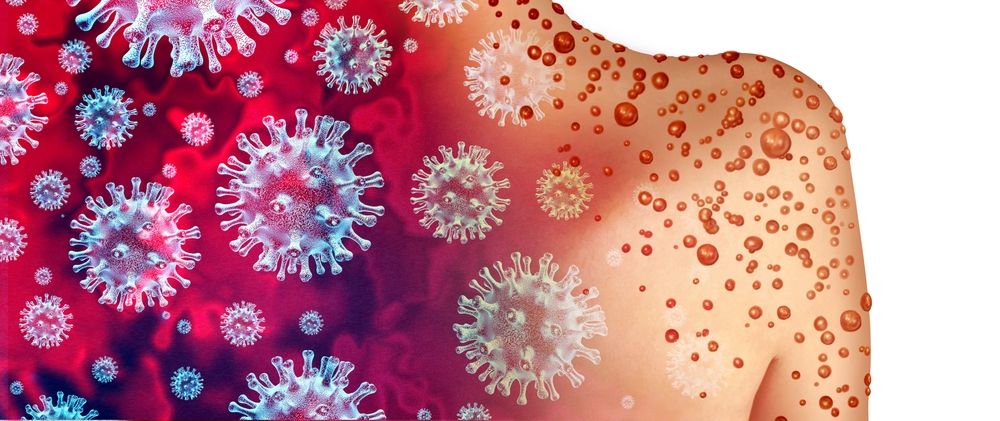May 25, 2022

News about recent monkeypox outbreaks in non-endemic countries have caused alarm and dread as many compare the mysterious disease spread to the COVID-19 pandemic. However, monkeypox and COVID-19 differ in many aspects, including mode and ease of transmission. The World Health Organization (WHO) advises non-endemic countries to remain alert and identify and isolate new cases to prevent further transmission.
What is monkeypox?
Monkeypox is a zoonotic (transmitting from animals to humans) viral illness, characterized by symptoms including rashes, fever, chills, and swollen lymph nodes. The disease was first identified in 1970 in the Democratic Republic of the Congo (DRC). Until recently, the illness had been detected in endemic countries of Central and Western Africa including Benin, Cameroon, the Central African Republic, the DRC, Gabon, Ghana (identified in animals only), Côte d’Ivoire, Liberia, Nigeria, the Republic of the Congo, Sierra Leone, and South Sudan1.
The current non-endemic monkeypox outbreak
As of May 21st, 2022, 92 laboratory-confirmed cases, 28 suspected cases, and zero deaths from Monkeypox have been reported in 12 non-endemic countries1. Many cases were individuals with no travel history to the endemic countries. In fact, the number of cases detected outside of Africa in the week of May 14-21 surpassed the total number detected outside the continent since 1970. This rapid spread is what has scientists on high alert2. Two distinct clades (groups of viruses with similar genetic sequences) have been identified, namely the West African and Congo Basin (Central African), with their respective epidemiological features.
Who’s been affected by the monkeypox outbreak?
To date, all cases identified in the present outbreak belong to the West African clade and have mainly (but not exclusively) been reported in men who have sex with men. Monkeypox virus is transmitted from one person to another by close contact with lesions, body fluids, respiratory droplets, and contaminated materials, such as bedding. The incubation period of monkeypox is usually from 6 to 13 days but can range from 5 to 21 days. There is no established evidence of presymptomatic or asymptomatic transmission for this disease.
The median age of presentation has increased from 4 years in the 1970s to 21 years between 2010 and 2019. The overall case fatality rate is 8.7% with a significant difference between the clades – Central African 10.6% (8.4 – 13.3) and West African 3.6% (1.7 – 6.8)3. The secondary attack rate (SAR), describing the probability of infection among close contacts of an infected person, ranges from 0.3% – 10.2%3, with only one study reporting a SAR of 50% in an outbreak with a median incubation period of 8 days4.
Case definitions and contact tracing guidelines have been released by the WHO1. Vaccination against smallpox has been shown to be protective against monkeypox with an efficacy of 85%. While one vaccine (MVA-BN) and one specific treatment (tecovirimat) were approved for monkeypox, in 2019 and 2022 respectively, they are not widely available1.
One Health can help control zoonotic diseases
The rapid spread of yet another zoonotic disease shows that now, more than ever, a One Health approach is needed to monitor and prevent the spread of illnesses between animals and humans with a focus on diseases that cause outbreaks due to dwindling herd immunity (as in the present case of monkeypox). We hope that moving forward, more effective intersectoral work between human, animal, and environmental health professionals at local, regional, and global levels can be supported to mitigate the emergence and spread of zoonotic disease outbreaks.
References
- Multi-country monkeypox outbreak in non-endemic countries [Internet]. [cited 2022 May 24]. Available from: https://www.who.int/emergencies/disease-outbreak-news/item/2022-DON385
- Kozlov M. Monkeypox goes global: why scientists are on alert. Nature [Internet]. 2022 May 20 [cited 2022 May 24]; Available from: https://www.nature.com/articles/d41586-022-01421-8
- Bunge EM, Hoet B, Chen L, Lienert F, Weidenthaler H, Baer LR, et al. The changing epidemiology of human monkeypox—A potential threat? A systematic review. PLOS Neglected Tropical Diseases. 2022 Feb 11;16(2):e0010141.
- Nolen LD, Osadebe L, Katomba J, Likofata J, Mukadi D, Monroe B, et al. Extended Human-to-Human Transmission during a Monkeypox Outbreak in the Democratic Republic of the Congo – Volume 22, Number 6—June 2016 – Emerging Infectious Diseases journal – CDC. [cited 2022 May 24]; Available from: https://wwwnc.cdc.gov/eid/article/22/6/15-0579_article











